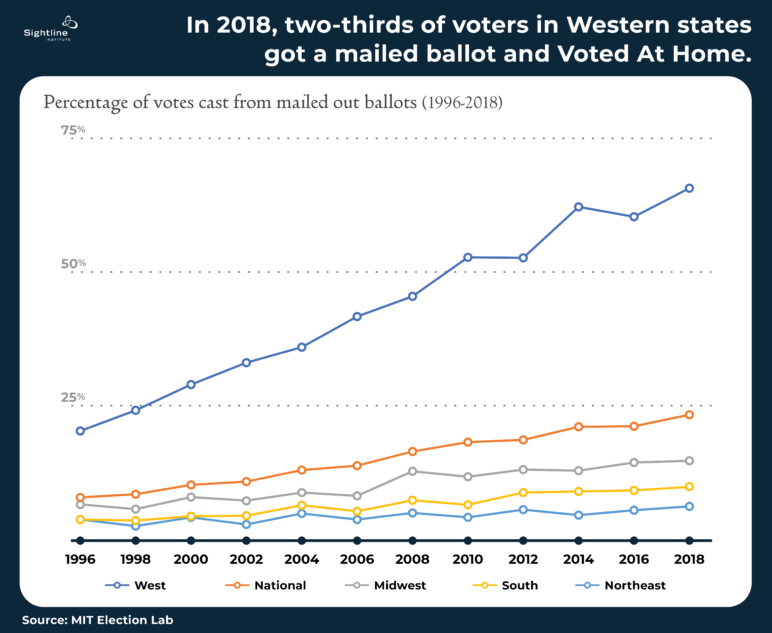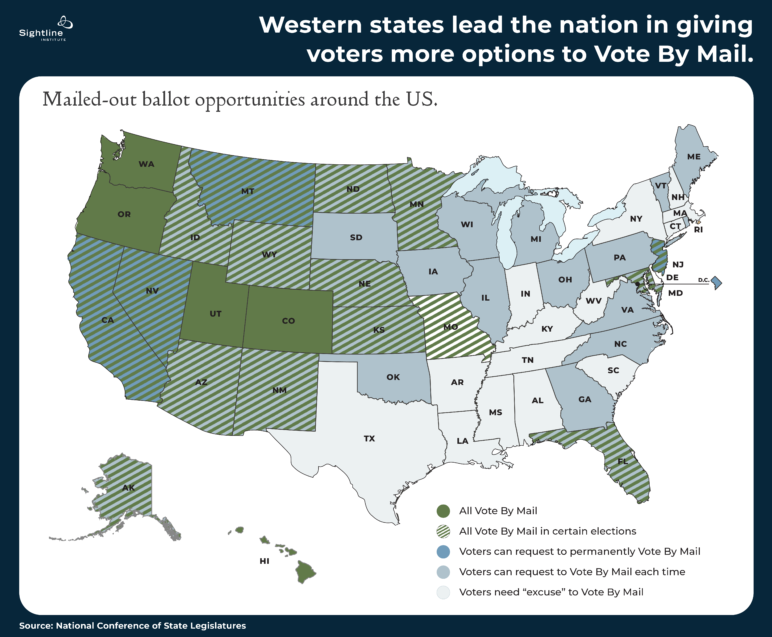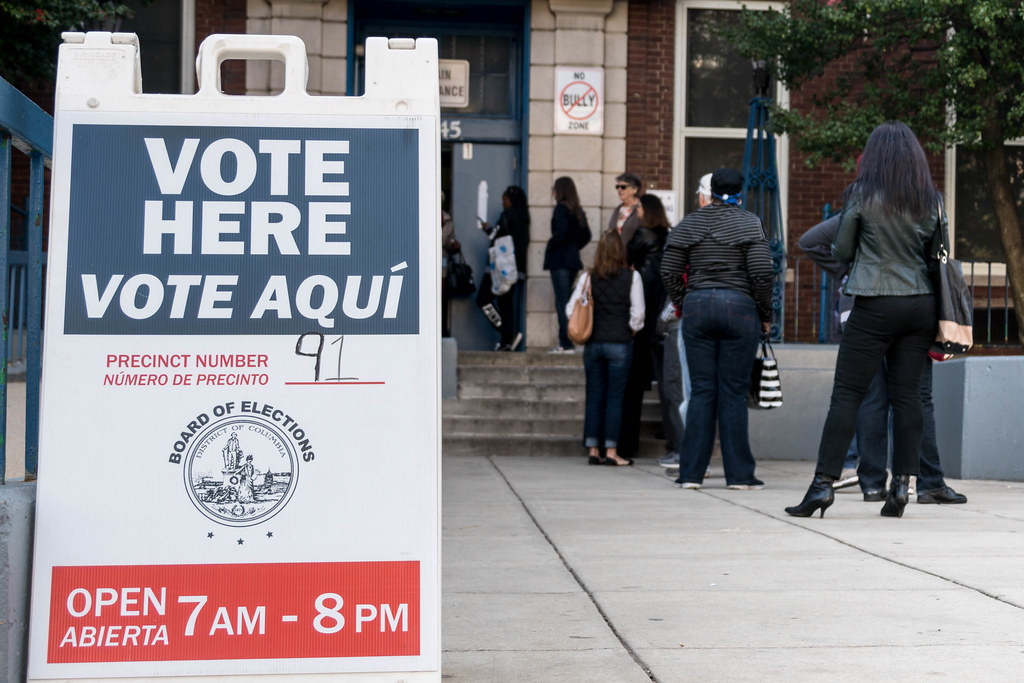How will coronavirus impact American elections this year? States and cities are starting to shut down schools and gatherings—even bars and restaurants—in an attempt to slow the virus’s spread, so will they close down polling places too? It’s quite possible. Some primaries are already affected. Even if polls are open, when social distancing is advised, voters and poll workers alike might heed warnings and stay away. Democracy only works if voters who want to can vote. The answer is mail-out ballots, or Vote By Mail.
Fortunately, this solution to make elections safe and accessible is readily available. And pandemic or no, this solution also makes all elections easier for voters to participate in—demonstrably boosting turnout (by a lot), cheaper to administer, and more secure (mailed-out paper ballots are not only virus-proof and suppression-proof, but Russia-proof too). Oregonians have been happily voting by mail it for more than a decade, and Oregon Senator Ron Wyden has introduced legislation (with Amy Klobuchar, MN) to help the rest of the nation do the same.
Vote By Mail means the state mails ballots to voters and voters can fill them in in the comfort (and safety) of their own home. You can then return the ballot in the mail or, just as often, bring the ballot to a secure drop-off location. That’s why we sometimes call it Vote At Home—the main point is that you can fill in the ballot at home on your own time. You may or may not return it by mail.
How quickly can we move to virus-proof Vote By Mail?
Some states mail ballots to all voters, while others mail to anyone who asks for a Vote By Mail ballot, and others will only mail to certain voters who have an “excuse” for wanting a ballot in the mail. That means most election administrators already have some experience with Vote By Mail. The question of the moment is: how quickly can those states that only mail out some ballots ramp up their efforts? For states wanting to mail more ballots, start with these resources from the National Vote at Home Institute and guidance from the Brennan Center for Justice.
Every single state, right now, mails out at least some ballots so that people can Vote By Mail or Vote At Home instead of coming to a polling place.<br />

As Klobuchar and Wyden put it, “The best way to ensure that this virus doesn’t keep people from the ballot box is to bring the ballot box to them.”
Western states are leading the way in helping voters Vote By Mail. In 2018, fully two-thirds of voters in the West used a mailed-out ballot. (See blue line in the graph below.) Other parts of the country have some work to do. In the Northeast, a paltry six percent of voters used a mailed-out ballot. Though some non-Western states have already made progress: in 2018, about one-third of Florida voters Voted By Mail. If all western states pushed their mailed-out ballot rates close to 100 percent, and other states boosted mailed-out ballot rates closer to western rates, the United States could empower voters to continue to participate in democracy this year with much less risk of polling places spreading disease.

Five states’ elections are already virus-proofed
Five states (green in the map below) already mail ballots to all registered voters: Colorado, Hawaii, Oregon, Utah, and Washington. These states are prepared for all voters to vote, virus-free.
Some states have certain elections that are Vote By Mail
Sixteen states (striped in the map below) mail all ballots in certain elections (usually special elections) or certain jurisdictions (often rural counties where it is burdensome to run polling places): Alaska, Arizona, California, Florida, Idaho, Kansas, Maryland, Minnesota, Missouri, Montana, Nebraska, Nevada, New Jersey, New Mexico, North Dakota, and Wyoming. These election administrators have experience with running an entire election by Vote By Mail. For example, in Idaho, 21 of the 44 counties have at least one precinct that uses only mailed ballots. These states could use their experience to increase their number of mailed ballots, or perhaps declare 2020 a special election that qualifies for letting everyone Vote By Mail.
In five states: Vote By Mail, by request, permanently
Five states plus the District of Columbia (blue in the map below) currently let anyone request to have their ballot mailed to them in every election. Once you sign up, ballots keep coming to your mailbox, no need to request it every time: Arizona, California, Montana, Nevada, New Jersey, and DC. These places have much of the experience and infrastructure they need in place. They just need to (1) encourage more voters to request their mailed-out ballot now, and (2) make sure they have the printing, mailing, and drop-off capacities to handle a surge in Vote By Mail ballots.
In many states: Absentee ballot, by request, each time
The twenty-three light blue states allow any voter to request to Vote By Mail, but they have to re-request the ballot every election or every year. Similar to the states above, these states already have the bones in place, but they should consider removing the requirement that voters have to re-request their mailed-ballot. Just assume that anyone who has the chance to Vote By Mail is going to love it and want to do it again.

Seveneen states require an excuse to Vote By Mail
Finally, the seventeen states (very pale blue in the map above) only let voters request to Vote By Mail if they have an “excuse” not to come to the polls, such as people with a disability. These states are in the worst position in the face of the pandemic, as they have limited capacity to print and mail ballots, and fewer voters have experienced Vote By Mail. However, the states and their voters could rise to the challenge. All but three of these excuse-required states allow people to request an absentee ballot in case of an emergency, usually defined as a medical emergency due to unforeseen illness. (Only Delaware, Mississippi and Missouri don’t). In these states, decisionmakers could decide that a global pandemic qualifies as an emergency and allow any voter in their state to request to Vote By Mail. And their election administrators could start preparing for a swell in the list of voters who want to Vote By Mail, and start educating voters about how to use a mailed-out ballot. As we take urgent steps to flatten the coronavirus curve, every voter has an “excuse” to want to Vote By Mail—not wanting to spread a pandemic.
The coronavirus might stop weddings and university classes for now, but we shouldn’t let it impair elections. We have the tools to ensure that everyone eligible can safely cast a ballot and have their voice heard. Vote By Mail is fair, safe, easy, and tested. We all should be able to vote from the convenience and safety of our home—for our own health and the health of our democracy.
Kristin Eberhard is a director at Sightline Institute. She researches, writes about, and speaks about climate change policy and democracy reform, with particular expertise on vote by mail and proportional representation. Find all her latest research here. Eberhard is available to discuss tested, safe, fair COVID-19 election practices, state by state. For interviews, speaking engagements, and media inquiries, contact Anna Fahey.

